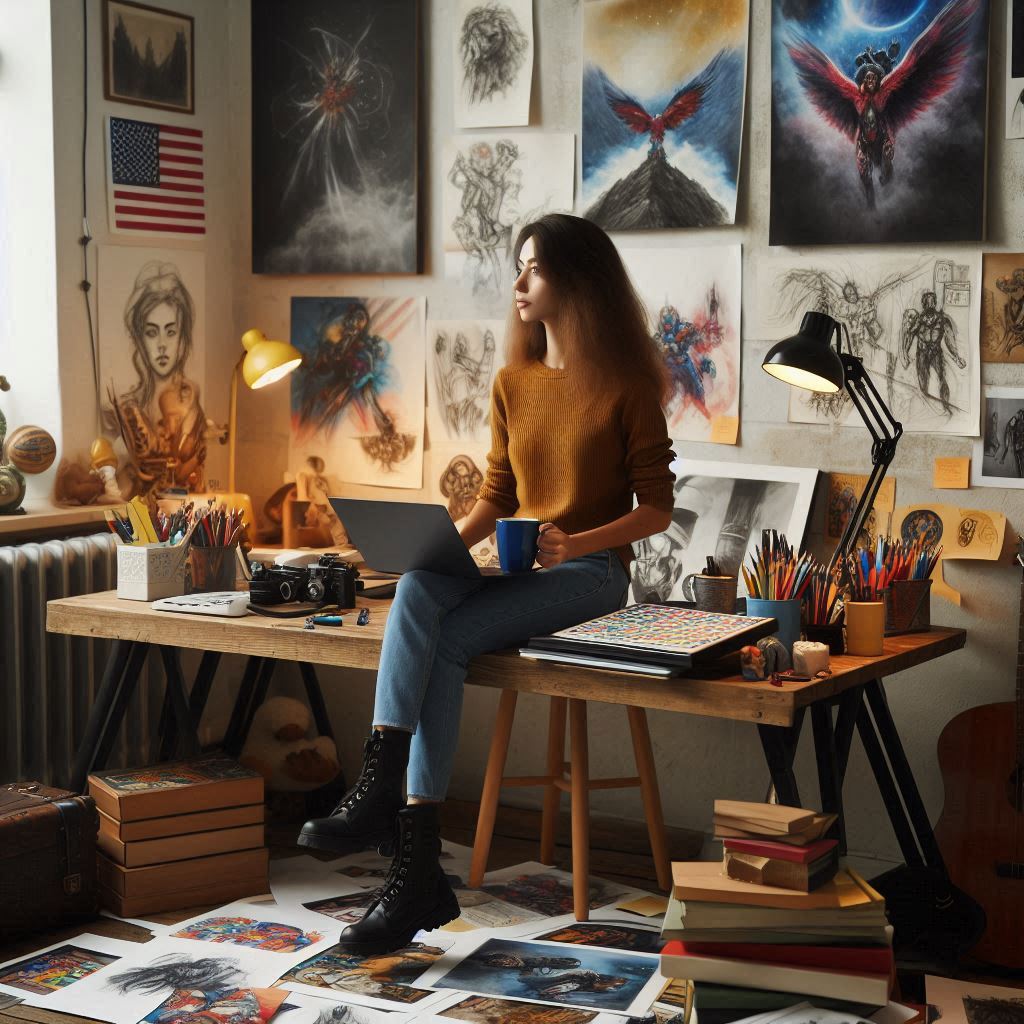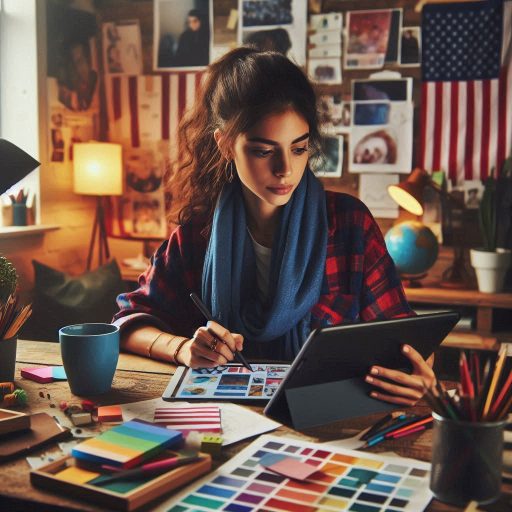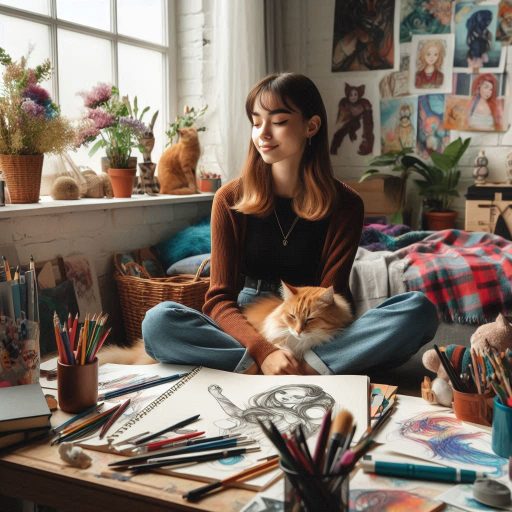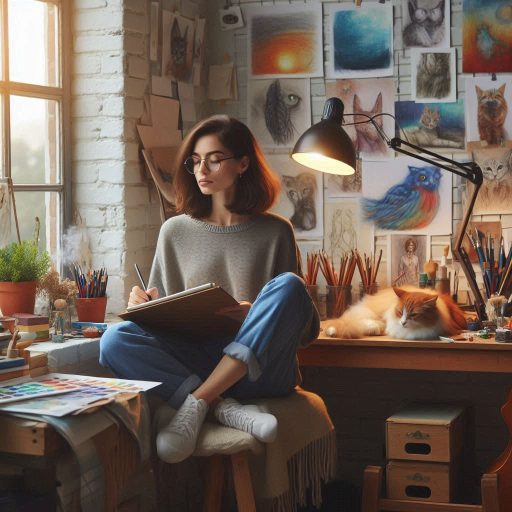Introduction
A professional concept artist shapes the visual identity of creative projects.
They bring ideas to life through illustrations and designs.
In video games, concept artists visualize characters, environments, and props.
Their work sets the tone and style for the entire game.
In film, concept artists create storyboards and key visuals.
They collaborate closely with directors and production designers.
This ensures the film’s aesthetic aligns with its narrative.
In animation, they design characters and settings, helping to establish the overall look.
Concept artists must understand color theory, composition, and lighting.
They often work with digital tools to create stunning visuals.
Strong communication skills are essential as they frequently present their ideas.
Collaboration with other artists and developers is also crucial.
By exploring various styles, concept artists inspire creative teams.
Their role often involves research to develop authentic and imaginative concepts.
A concept artist’s day can include brainstorming sessions, sketching ideas, and refining designs.
Each project presents unique challenges and opportunities for creativity.
Concept artists play a vital role in shaping the visual language of multiple industries.
Morning Routine
The typical morning routine of a concept artist
A concept artist‘s morning routine sets the tone for a productive day.
Each artist has unique habits that fuel their creativity and focus.
Let‘s explore a typical morning routine, highlighting its significance.
How concept artists start their day, whether it be with coffee, exercise, or brainstorming sessions
Most concept artists wake up early to maximize their productivity.
They rise before the sun to embrace quiet moments.
This early start allows them to gather their thoughts and plan their day.
Artists often enjoy a few peaceful minutes to reflect before diving into their tasks.
Coffee becomes a vital part of their morning ritual.
Artists brew their favorite blend to kickstart their day.
The rich aroma fills the kitchen, sparking motivation.
Sipping coffee helps them awaken their senses and stimulate their minds.
This small act provides a comforting routine amidst the daily hustle.
Many concept artists incorporate exercise into their mornings.
They engage in yoga, stretching, or brisk walks to energize their bodies.
Physical activity boosts endorphins, enhancing focus and creativity.
Even a short workout can provide the mental clarity needed for the tasks ahead.
Exercise also helps reduce stress, allowing artists to approach their work with a fresh perspective.
After coffee and exercise, artists often dedicate time to brainstorming.
They jot down ideas in a sketchbook or digital format.
This practice sparks creativity and helps them visualize concepts.
Some artists create mind maps to explore various themes and styles.
This brainstorming session becomes crucial in shaping their projects for the day.
Setting goals is an essential part of the morning routine.
Concept artists outline their tasks for the day, prioritizing what needs attention.
These goals help them maintain focus and motivation throughout the day.
They may categorize tasks into urgent, important, and long-term projects.
This organized approach ensures a sense of accomplishment as they check off completed tasks.
The importance of setting a positive tone for the day ahead
A positive mindset is vital for a successful day.
Concept artists often engage in affirmations or gratitude practices.
They remind themselves of their skills and achievements, fostering confidence.
By starting the day with positivity, artists combat self-doubt and stress.
This mental framework allows them to tackle challenges more effectively.
Before diving into their projects, artists prepare their workspaces.
They declutter their desks and organize their tools.
A tidy environment fosters creativity and minimizes distractions.
Artists often create an inspiring atmosphere with music or art pieces.
This setup signals their brain that it‘s time to create.
A concept artist’s morning routine lays the foundation for a successful day.
From waking up early to preparing their workspace, each step enhances productivity.
By setting a positive tone, artists equip themselves for creative challenges ahead.
Read: Essential Skills for Aspiring Costume Designers
Creative Process
The Creative Process of a Concept Artist
Concept artists play a vital role in visual storytelling.
They shape the look and feel of characters, environments, and objects in various media.
Their creative process is structured yet fluid, allowing for exploration and innovation.
Let‘s delve into how they work.
How concept artists gather inspiration, research reference materials, and brainstorm ideas
Inspiration often strikes at unexpected moments.
Concept artists actively seek out new ideas daily.
They draw from multiple sources, including nature, art, and popular culture.
Visiting museums or galleries often sparks creativity.
Engaging with fellow artists can also generate fresh perspectives.
Artists also explore online platforms.
Websites like Pinterest and ArtStation serve as treasure troves of inspiration.
Browsing these sites allows them to see emerging trends and techniques.
They follow industry leaders on social media to stay current.
Attending conventions and workshops fuels their passion and provides networking opportunities.
Once artists gather inspiration, they dive into research.
They understand that reference materials are essential for developing realistic designs.
Concept artists utilize various resources, such as books, films, and online databases.
They study anatomy, architecture, and color theory to refine their work.
Many artists keep visual libraries.
These collections consist of images, sketches, and notes that resonate with them.
They curate these libraries over time, creating a rich pool of ideas.
When a project begins, they sift through this collection for relevant references.
This research process enhances their understanding and informs their designs.
After gathering inspiration and references, artists move on to brainstorming.
They often use mind maps to organize their thoughts.
This technique allows them to explore different directions for their designs.
They jot down ideas and draw quick sketches to visualize concepts.
Collaboration plays a crucial role during brainstorming sessions.
Artists discuss their ideas with team members and gather feedback.
This collaborative environment often leads to unexpected breakthroughs.
They remain open to suggestions, knowing that fresh perspectives can enhance their work.
How concept artist translate their ideas into sketches, digital renderings, or 3D models
Once they settle on a concept, artists start translating their ideas into visuals.
They begin with rough sketches to outline the design’s basic shapes.
These initial sketches are quick and flexible, allowing for easy adjustments.
Artists focus on capturing the essence of their ideas.
After refining the sketches, they move to digital rendering.
Software like Adobe Photoshop and Procreate become their primary tools.
Artists create detailed illustrations that showcase color, texture, and lighting.
They often layer elements to add depth and realism to their designs.
For projects requiring 3D models, artists utilize software like Blender or ZBrush.
They sculpt their designs, paying attention to form and proportions.
This process allows them to visualize their ideas from multiple angles.
They produce models that can be animated or integrated into larger projects.
The creative process of a concept artist is a dynamic journey.
From gathering inspiration to translating ideas into visual formats, every step counts.
This structured yet flexible approach fosters creativity and innovation.
Through dedication and passion, concept artists bring imaginative worlds to life.
Read: Visual Merchandiser: Job Market and Opportunities
Collaboration and Communication
Importance of collaboration in the life of a concept artist
Collaboration stands at the core of a concept artist’s daily life.
Artists rarely work in isolation; they thrive within a team environment.
Each project requires input from various creative professionals.
Art directors, designers, and other team members contribute unique perspectives.
This collaborative spirit shapes the final product, ensuring it meets the project‘s vision.
Working with Art Directors, designers, and other team members
Concept artists work closely with art directors from the outset.
Art directors provide essential guidance and direction.
They share the overall vision and goals for the project.
This exchange allows concept artists to align their ideas with the larger narrative.
Regular check-ins ensure everyone stays on the same page.
These discussions foster an environment of creativity and innovation.
Designers play a crucial role in the collaboration process.
They bring the technical aspects of the project to life.
Concept artists and designers often brainstorm together, exploring ideas and refining concepts.
This teamwork leads to more cohesive and functional designs.
The synergy between artists and designers enhances the visual storytelling aspect of a project.
Transform Your Career Today
Unlock a personalized career strategy that drives real results. Get tailored advice and a roadmap designed just for you.
Start NowThe Importance of Clear Communication and feedback throughout the creative process
Effective communication is vital throughout the creative process.
Concept artists must articulate their ideas clearly to the team.
They present their concepts using sketches, mood boards, and digital mock-ups.
These tools help convey their vision and invite constructive feedback.
Open discussions allow for a richer exchange of ideas.
Feedback serves as a cornerstone for improvement.
Concept artists welcome critique from their peers and art directors.
This feedback loop fosters growth and innovation.
When team members share their insights, it helps the artist refine their work.
Embracing feedback leads to stronger, more polished designs.
Daily meetings and brainstorming sessions often facilitate collaboration.
Concept artists regularly gather with their teams to discuss progress and challenges.
These meetings encourage open dialogue and creative problem-solving.
Artists can voice their concerns and ideas, ensuring everyone feels included.
This inclusivity strengthens the overall project outcome.
In addition to formal meetings, casual conversations also play a significant role.
Creative ideas often emerge during informal chats or team lunches.
These moments provide a relaxed atmosphere for brainstorming.
Artists can express themselves freely, leading to unexpected insights.
Understanding each team member’s strengths is crucial for effective collaboration.
Concept artists recognize who excels in what areas.
This knowledge allows them to delegate tasks appropriately.
By leveraging each person‘s expertise, the team can achieve a higher level of creativity.
Collaboration and communication are essential in a concept artist’s life.
The synergy created through teamwork enhances creativity and innovation.
Clear communication fosters a productive environment.
Feedback helps refine ideas and elevate the final product.
By working closely with art directors, designers, and team members, concept artists contribute to captivating visual experiences.
Read: Visual Merchandising: Best Practices for Beginners
Project Management
Balancing Multiple Projects
Professional concept artists often juggle multiple projects simultaneously.
They need to maintain focus while shifting between distinct creative tasks.
Staying organized is critical, as each project may have different timelines and requirements.
Artists must also ensure consistency in quality, regardless of workload or the nature of the project.
Using tools like project management software helps them track deadlines and progress effectively.
How concept artist prioritize tasks, meet deadlines, and adapt to changes in direction
When working on several projects, prioritization is key.
Concept artists assess the urgency and importance of each task before proceeding.
They break down larger projects into smaller, manageable tasks to stay on track.
Clear communication with clients or team members helps in setting expectations and determining which project requires immediate attention.
Prioritizing is a daily routine, allowing them to stay ahead of deadlines.
Concept artists are accustomed to working within tight deadlines.
They create daily schedules and timelines to ensure steady progress.
Regular check-ins and progress updates are essential for keeping track of time.
Artists might work in sprints, completing tasks in bursts while staying mindful of quality.
They understand that time management is crucial to avoid last-minute rushes or sacrificing quality for speed.
In creative industries, project directions often change unexpectedly.
A concept artist must be flexible, able to adapt to revisions swiftly.
They might receive feedback that requires reworking concepts or changing the entire direction.
Flexibility ensures that the artist can accommodate changes without losing focus or motivation.
Quick adaptation also reflects their problem-solving skills, ensuring projects stay on track despite unexpected shifts.
The importance of organization and time management skills in their profession
Staying organized is paramount in managing multiple projects efficiently.
Artists use tools like task managers, calendars, and note-taking apps to stay on top of their workloads.
By keeping clear documentation of ideas, files, and deadlines, they minimize confusion.
Proper organization also allows them to revisit older projects if necessary without getting lost in a sea of tasks and files.
Time management is a vital skill for concept artists, who often work under high-pressure environments.
They allocate specific time blocks to different projects or tasks, ensuring they progress on all fronts.
Avoiding distractions and staying disciplined is crucial, especially when working remotely.
Time tracking tools help them monitor how much time they spend on each task, enabling better planning in the future.
Effective project management is critical for concept artists to succeed.
By balancing projects, prioritizing tasks, meeting deadlines, adapting to changes, and honing organization and time management skills, they navigate the demands of their profession smoothly.
These skills not only ensure the completion of high-quality work but also foster long-term professional growth.
Read: Collaborating with Other Creative Roles

Skill Development
Concept artists thrive in an ever-evolving industry.
They consistently work on improving their skills to stay relevant.
Each day brings new challenges and opportunities for growth.
This constant push for development is crucial for their success.
How concept artists continuously work on improving their skills
Concept artists engage in various practices to enhance their abilities.
They dedicate time to sketching daily.
This routine hones their drawing techniques and improves their overall creativity.
Artists often explore different mediums, from traditional pencil to digital painting.
Experimenting with various tools expands their artistic range.
Additionally, artists seek feedback on their work.
Constructive criticism helps them identify areas for improvement.
They often share their work on social media platforms.
Engaging with a community of peers fosters a spirit of collaboration.
This interaction provides invaluable insights into their craft.
The importance of staying updated on industry trends and technological advancements
Keeping abreast of industry trends is essential for concept artists.
The art world shifts rapidly, influenced by technology and popular culture.
Artists regularly research new styles, themes, and techniques.
They follow influential artists and studios to understand current trends.
Technological advancements also play a significant role in their development.
Artists explore the latest software updates and tools.
They adapt to changes in the industry, ensuring they utilize the best resources.
Learning about emerging technologies like virtual reality and augmented reality is vital.
These innovations open new avenues for creative expression.
The value of attending workshops, seminars, and networking events to enhance their abilities
Attending workshops and seminars significantly enhances an artist‘s skills.
These events offer hands-on experience with experts in the field.
Artists learn new techniques and gain fresh perspectives on their work.
They often discover innovative approaches to problem-solving during these sessions.
Networking events provide additional benefits.
Artists connect with industry professionals, potential collaborators, and mentors.
Building relationships in the industry can lead to new opportunities.
Networking also fosters a sense of community among artists.
Many successful concept artists attribute their growth to these experiences.
They often return to their studios inspired and motivated.
The knowledge gained at workshops and seminars can transform their approach to art.
Networking plays a crucial role in an artist‘s journey.
By meeting others in the industry, they share resources and knowledge.
Collaboration often leads to exciting projects and creative partnerships.
Artists also gain insights into job opportunities through these connections.
Moreover, attending events creates a platform for showcasing their work.
Artists can present their portfolios and receive feedback from industry leaders.
This exposure can lead to valuable connections and future projects.
Skill development is a continuous journey for concept artists.
They actively seek opportunities to improve their craft.
Staying updated on industry trends and technological advancements is essential.
Workshops, seminars, and networking events provide invaluable experiences that enhance their abilities.
By prioritizing skill development, artists ensure their growth and success in this competitive field.
Client Interaction
Engaging with Clients and Stakeholders
Client interaction plays a vital role in the life of a concept artist.
Building strong relationships with clients is crucial for successful projects.
Concept artists often communicate directly with stakeholders, understanding their needs and expectations.
This interaction shapes the creative process and influences the final design.
The process of presenting and pitching ideas, receiving feedback, and making revisions
When it‘s time to present ideas, concept artists prepare thoroughly.
They create visual presentations to effectively communicate their concepts.
These presentations often include sketches, digital renderings, and mood boards.
Each piece serves as a visual guide to convey the artist‘s vision.
The artist articulates the ideas clearly, ensuring that clients grasp the creative direction.
During the pitch, the artist addresses specific project goals.
They highlight how their concepts align with the client‘s vision.
This alignment fosters trust and encourages collaboration.
Engaging storytelling enhances the presentation, capturing the client‘s attention.
Artists often encourage questions to clarify any uncertainties.
Showcase Your Business Today
Reach thousands of readers actively exploring professional services. Publish your business profile and grow your audience now.
Publish NowAfter the presentation, artists eagerly await feedback.
They understand that constructive criticism is vital for improvement.
Clients share their thoughts on the concepts presented.
This dialogue allows artists to gauge the client‘s reactions.
They actively listen and take notes, ensuring no detail is overlooked.
Effective feedback sessions can lead to deeper discussions.
Artists may ask probing questions to understand the client‘s perspective.
This exploration helps identify any misalignments between the artist‘s vision and the client‘s expectations.
Artists must remain open-minded and adaptable during these discussions.
Once the feedback is received, the revision process begins.
Artists prioritize changes based on client input and project requirements.
They approach revisions with creativity, finding innovative ways to incorporate suggestions.
Balancing artistic integrity and client desires can be challenging.
However, successful concept artists navigate this landscape with finesse.
Each revision cycle strengthens the project.
Artists understand that refining concepts often leads to the best results.
They communicate openly about what can and cannot be changed.
This transparency builds trust and fosters a positive working relationship.
The need for effective communication and understanding of client expectations
Effective communication underpins every interaction with clients.
Concept artists must articulate their ideas clearly and confidently.
They also need to demonstrate an understanding of design terminology.
This knowledge helps bridge any gaps between artistic vision and client expectations.
Furthermore, artists must practice active listening.
They should validate client concerns while providing expert insights.
This two-way communication fosters collaboration and enhances project outcomes.
Building rapport with clients often leads to future opportunities and referrals.
Client interaction is a fundamental aspect of a concept artist’s daily life.
Presenting ideas, receiving feedback, and making revisions require strong communication skills.
By understanding client expectations and fostering collaboration, artists ensure their creative visions resonate with stakeholders.
Successful interactions lead to exceptional designs that meet clients’ needs.
Problem-Solving
The problem-solving skills required in the life of a concept artist
Concept artists face unique challenges daily.
They must tackle creative hurdles, technical constraints, and client feedback.
Problem-solving stands as a vital skill in this profession.
Here‘s how concept artists navigate these issues with innovative solutions.
How concept artist address creative challenges, technical limitations, and client feedback
Creative challenges frequently arise during a project.
Artists often face vague briefs or shifting client expectations.
In such cases, they must think critically.
They analyze the project‘s needs and redefine their creative approach.
For example, an artist might sketch multiple concepts based on a single idea.
This process allows them to explore various directions and find the best fit.
Additionally, collaboration plays a significant role.
Artists engage with other team members, such as writers and designers.
This teamwork fosters a broader perspective, sparking new ideas.
By discussing concepts openly, they can overcome creative blocks together.
Brainstorming sessions often lead to unexpected breakthroughs.
Technical limitations pose another hurdle for concept artists.
They often work with various software tools and hardware.
Sometimes, these tools might not meet their artistic vision.
In such instances, artists must adapt quickly.
They learn to work within their tools‘ constraints to achieve desired results.
For example, if a software tool lacks a specific feature, artists may seek alternative methods.
They might combine traditional techniques with digital tools to enhance their work.
This blending of styles can create unique visuals that stand out.
It also showcases their ability to innovate under pressure.
Client feedback is an essential part of the creative process.
Concept artists must accept constructive criticism and incorporate it effectively.
When clients express dissatisfaction, artists listen carefully.
They identify the root cause of the issue and propose solutions.
For instance, a client might request a character redesign.
Instead of feeling discouraged, an artist views this as an opportunity.
They revisit their original sketches and brainstorm new ideas.
They might create a mood board to visualize different options.
This visual representation aids in conveying new directions to the client.
Thinking Outside the Box
Thinking outside the box is crucial for concept artists.
They often face unconventional challenges that require unique solutions.
For instance, an artist might need to design a creature for a fantasy game.
Traditional design methods may not suffice.
Instead, they could study real animals, blending various features into one.
Additionally, artists can draw inspiration from unexpected sources.
They might explore different cultures or historical periods to influence their designs.
This openness to diverse influences helps them create innovative concepts.
Problem-solving remains at the heart of a concept artist‘s daily routine.
Through creativity, technical adaptability, and open-mindedness, they navigate the complexities of their role.
Each challenge presents an opportunity for growth and innovation, driving their artistic journey forward.
See Related Content: Top Industries Hiring Art Directors Right Now
Gain More Insights: The Role of an Advertising Designer in Brand Identity
Work-Life Balance
Maintaining a healthy work-life balance is crucial for a concept artist.
The creative industry often demands long hours and tight deadlines.
Without balance, artists can easily experience burnout and diminished creativity.
To sustain a thriving career, prioritizing personal well-being becomes essential.
The importance of maintaining a healthy work-life balance as a concept artist
A concept artist’s work often blends passion with profession.
This blend can blur boundaries, leading to overworking.
However, consistent long hours can harm mental health and creativity.
Balance allows artists to recharge and stay inspired.
Taking breaks can enhance focus and productivity.
A well-rested mind produces better ideas and designs.
Strategies for managing stress, avoiding burnout, and finding time for personal interests and hobbies
Effective time management is key to avoiding stress.
Creating a daily schedule helps allocate time for tasks and breaks.
Set clear, achievable goals to maintain motivation.
Use tools like planners or digital apps to track progress.
Breaking larger projects into smaller tasks can make work feel manageable.
Additionally, practicing mindfulness can alleviate stress.
Techniques like deep breathing or meditation provide a mental reset.
Spending a few minutes in silence can clarify thoughts and boost creativity.
Don‘t underestimate the power of a walk outside to refresh your mind.
Burnout creeps up silently but has severe consequences.
Recognizing signs early can help prevent it.
Feeling tired, unmotivated, or detached from work often signals burnout.
Listen to your body and take breaks when needed.
Limit your workload by setting boundaries.
Communicate with clients about your capacity and deadlines.
Avoid saying yes to every project that comes your way.
Establish a schedule that prioritizes rest alongside work.
A balanced schedule fuels creativity and prevents fatigue.
Engaging in personal interests outside work can rejuvenate creativity.
Hobbies provide a necessary escape from professional demands.
Whether it‘s painting, gaming, or reading, indulge in activities that spark joy.
These moments of leisure often inspire new ideas in your professional work.
Schedule regular time for these hobbies.
Treat this time as non-negotiable, just like a work meeting.
Prioritizing personal interests boosts happiness and satisfaction.
A fulfilled artist brings more energy and enthusiasm to their projects.
Self-Care Practices and Setting Boundaries
Incorporating self-care practices is vital for maintaining balance.
Regular exercise promotes physical and mental health.
Even short workouts can enhance mood and reduce stress.
Prioritize sleep, as it directly impacts creativity and productivity.
A well-rested artist performs better in every aspect of their work.
Establishing boundaries protects your personal time.
Set a designated work schedule and stick to it.
Turn off notifications after work hours to minimize distractions.
Communicate your boundaries with colleagues and clients.
A strong commitment to work-life balance enhances overall satisfaction in both personal and professional spheres.
Conclusion
A day in the life of a professional concept artist is both complex and rewarding.
Artists blend creativity with technical skill every day.
They navigate tight deadlines while collaborating with teams.
Each project brings unique challenges that spark innovation.
Concept artists must adapt to different styles and client needs.
This versatility fuels their growth and enriches their portfolios.
Throughout this blog, we explored various aspects of their daily routines.
From brainstorming ideas to refining final designs, every moment counts.
The journey requires passion and dedication.
Aspiring artists should embrace this dynamic environment.
Pursuing a career in concept art is not just a dream; it‘s achievable.
Set clear goals, build a strong portfolio, and network with industry professionals.
Don‘t be afraid to seek feedback and learn from others.
Stay committed to honing your craft and pushing boundaries.
Remember, success in this field comes from resilience and hard work.
If you love what you do, the rewards will follow.
Embrace your passion and embark on this exciting journey.
[E-Books for Sale]
The Big Book of 500 High-Paying Jobs in America: Unlock Your Earning Potential
$19.99 • 500 High-Paying Jobs • 330 pages
Explore 500 high-paying jobs in America and learn how to boost your career, earn more, and achieve success!
See All 500 High-Paying Jobs of this E-Book
1001 Professions Without a Degree: High-Paying American Jobs You Can Start Now
$19.99 • 1001 Professions Without a Degree • 174 pages
Discover 1001 high-paying jobs without a degree! Unlock career tips, skills, and success strategies for just $19.99!




